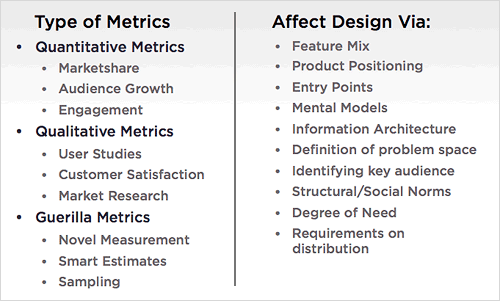The latest volley in the data vs. design debate comes from the unfortunately named New York Time article: Data, Not Design, Is King in the Age of Google. I say unfortunately because the title sets things up as a battle where only one -“design” or “data”- can be king.
The article itself, however, takes a more nuanced perspective with Douglas Bowman (whose departure from Google recently surfaced this debate anew) acknowledging that in his new role as Creative Director at Twitter, “using data is fundamental to what we do”. And therein lies the issue. It’s not data versus design. It’s data and design. Let me elaborate.
Data Informs Design
In our Influencing Strategy by Design course, Tom Chi and I spent a fair amount of time discussing the relevance of data for product design and strategy. To illustrate, pick any source of data from the left column in the image below and you can see how it might impact design decisions in the right column.

For example, market research can inform your product positioning –how you’ll talk about your product to consumers using the language of design. Engagement metrics might pivot your information architecture around centers of activity that currently exist in your product. And so on…
A Handle on Data Builds Credibility
Being data-aware from the beginning of a project, enables designers to understand problems before they try to solve them. Being able to frame problems is crucial to having a say in solving them. As Dan Roam, author of Back of the Napkin, likes to say “whoever best describes the problem is the person most likely to solve the problem.”
So if you want a seat at the table, (and most design teams really, really do) make sure you know the data that matters to your organization. Then use your existing design skills to illuminate relationships, considerations, decisions, and implications of that data at a strategic level.
In today’s digital world, getting clarity into the problems organizations face is sometimes more valuable than coming up with solutions. There are many more designers trying to provide solutions than there are trying to clarify problems and that creates an very real opportunity for designers looking for more strategic influence in their organization.
Data is Not the Only Way to Make Decisions
There’s more than one way to make software user interface decisions and thereby “move pixels” on the screen: designing, optimizing, and managing. Don’t confuse company cultures that make decisions based on “optimizing” (explicitly testing isolated variables to drive very specific behaviors) with those using data to design. Data is an immensely valuable input but it shouldn’t be the only factor considered when making decisions.